Local Exhaust Ventilation (LEV)
Local Exhaust Ventilation (LEV) is a ventilation system that takes hazardous substances (gases, vapour, fume, mist, dust etc) out of the air so that they can't be breathed in.
Local exhaust ventilation (LEV) can either extract to an external location or recycle air, but in all cases it has the aim of removing contaminated air and if recycled back into a room, filtering to prevent people breathing in hazardous substances.
Examples of LEV used at UCL include:
- Fume cupboards
- Microbiological safety cabinets
- Capture hoods
- Gas Safety Cabinets.
> Further information on each type of LEV
General information
- Why we use LEVs
LEV helps prevent users from inhaling hazardous substances, but it can only provide protection if selected, installed, used and maintained correctly.
LEV is classed an engineering control and is a good measure to use, however it should not be used alone. Always consider using control measures in combination, for example:
- Avoid a hazard or substitute it with something less harmful (less concentrated chemical, different material etc.)
- Limit frequency of use and duration of exposure to hazardous substances
- Use procedural controls (methods, operating procedures, work instructions)
- Wear appropriate personal protective equipment (PPE)
Remember - always read your local risk assessments - they will identify hazards in your work area, the controls you need to follow including LEV. If you use LEV but it is not mentioned on a risk assessment, make sure the document is updated.
Every year, thousands of people in the UK develop occupational diseases from breathing in dusts, fumes or other airborne contaminants at work. Make sure you're not one of them!
For UCLs arrangements for ensuring that LEV is examined and tested by competent person see the following link:
- How to select an LEV
- 3 Steps to selecting an LEV:
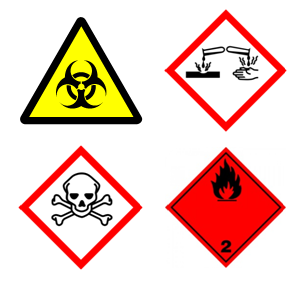
- Consider the hazards for which LEV is required - what materials are you working with?
- Assess the risks by identifying the likelihood and consequences of exposure.
- Identify the equipment that will provide adequate containment or extraction - the level of control must reflect the severity of risk.
Ask yourself these questions:
- Is the LEV suitably sized to allow comfortable working?
- Is it able to extract the volume of air required?
- Do you know what filters are required and how often to change them?
- Does the LEV have suitable controls and indicator gauges / lights?
- Do you know what the controls do and what the indicators mean?
- When LEV doesn't work as well as it should, a common reason is that the hood doesn't catch or contain contaminants effectively. It is important to match the hood to the source that you want to control.
- How to use
- LEV can only provide protection if used correctly. Efficient extraction from the working area of the LEV depends on air flowing into and passing through the equipment as intended.
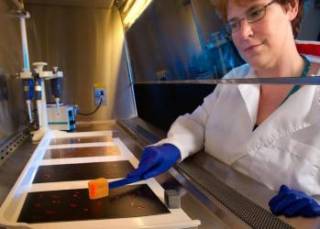
To maintain air flow in fume cupboards and microbiological safety cabinets, remember the following:
- Limit what you put inside LEV to the minimum needed for the work - do not use it as a storage area for chemicals or equipment!
- Avoid using large items of equipment inside the LEV. If you do need to use equipment inside a cabinet, use lab jacks to raise the equipment and allow air flow underneath it
- Make sure lightweight items (filter papers, aluminium foil etc.) are secured to prevent them being drawn into ducting or blocking filters
- Keep the first 15cm inside the cabinet free of obstructions to make sure air is drawn into the cabinet effectively - mark this line as a reminder
- Maintain a working opening of no more than 50cm high - mark this maximum height as a reminder
- Never remove horizontal sliding sash panels during use as it will disrupt containment
- Keep the cabinet clean and tidy and leave it in a good condition after use - ensure redundant equipment is removed and surfaces are cleaned
- Dispose of waste following local procedures, don't let it accumulate or leave it in LEV for longer than necessary
If experiments under LEV are left unattended or overnight, remember to display signs and emergency contact details.
Finally, report faults or problems and encourage others to, if they think that LEV isn't working properly. If necessary, take the equipment out of service or make sure it is repaired straight away.
- How to maintain
- You must regularly check your LEV and also have it 'thoroughly examined and tested' at least every 14 months by a competent individual, usually a service contractor. This will ensure it works well and continues to protect you and those you work with.
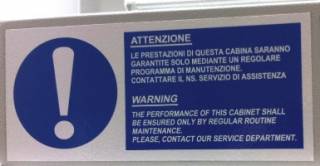
How often you check your LEV and what checks you may need to perform depend on how complicated the system is; how likely it is to fail and the consequences if it does. Complicated LEV that will have a serious impact if it fails will need more frequent checks and maintenance.
LEV used for radioactive work may need additional maintenance and/or monitoring checks. If filters are changed during maintenance, particular consideration should be given to disposal. For more advice on use, maintenance and decommissioning of LEV used for radioactive work, please contact the UCL Radiation Protection Officer.
Annual checks and maintenance
- Moving parts that may wear, such as fan bearings
- Non-moving parts, such as hoods, ductwork and seals (which can suffer physical or chemical damage and wear)
- Parts that deteriorate with use
- Items that need regular attention, such as filters that need replacing
Annual test information labels should be displayed and include the test date, who carried out the testing and indicate whether the unit has been passed for use.
Local, routine checks recommended weekly or monthly and can include:
- Operation of control switches / gauges
- Checking alarms for sash position or airflow (if installed)
- Checking sash mechanisms
- Visual check for signs of corrosion or damage
- Checking lights function correctly
If you find any problems during local checks please contact UCL's Customer Services Centre
Maintenance responsibility
Maintenance of LEV is a local responsibility. In your department or team, assign responsibilities for LEV checks and maintenance. If necessary, write these assignments down
If you do not already have arrangements for statutory testing of your equipment, UCL Estates will be able to provide information on suitable contractors for the statutory testing of LEV.
Record keeping
Keep a written record of all LEV checks and maintenance to show that it has been done and that your equipment is working as well as it should. Keeping a history of maintenance will also help you understand trends and fix problems before they get worse!
- Operating procedures
LEV suppliers should provide an operating manual or operating procedure with equipment. This should be retained and used locally, either as supplied or used as the basis for a local procedure. Consider posting your equipment procedures on or near the LEV, to make sure staff and students have the information they require at point of use.
- Thorough Examination
Thorough examination tests the LEV against the performance recorded in its commissioning report. It should include airflow measurements, checks on control effectiveness and, possibly, exposure measurements. If you don't have the initial design performance data, you will not know whether your system is working correctly, so you may need to have your system commissioned.
Following a thorough examination, the examiner will attach a 'tested' label to the LEV. This will include the name of the examiner and the date of the next test. If a hood has clearly failed, then a red 'fail' label will be attached instead, and urgent action will be necessary. The examiner will give you a report of the examination and test, which should include a prioritised action plan listing anything that you need to do.
If the examination and test show that the LEV isn't adequately controlling people's exposure to airborne contaminants, stop using the equipment and repair the LEV. If you want work to continue while you arrange repair, employees will need further protection, such as suitable PPE. The system should carry a red 'fail' label until it has been repaired.
A suitable record of the examination and test should be kept for a minimum of 5 years from the date on which it was made
Types of Local Exhaust Ventilation (LEV)
- Fume Cupboard
- Fume cupboards are designed to prevent exposure to harmful chemicals but the ability of a fume cupboard to prevent exposure depends on a number of factors.
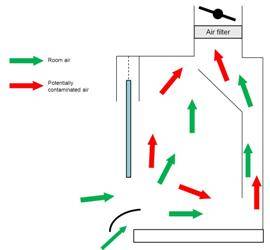
These include:
- Choosing the most appropriate type of fume cupboard
- Correct siting of a fume cupboard in relation to other air handling systems, walkways, doors and other air flows within a room
- Correct use of the equipment
- Regular maintenance and testing
Fume cupboards generally fall into two categories - ducted and re-circulating:
Ducted fume cupboards are the most commonly found type and suitable for most work with chemicals, including radioactive materials (subject to risk assessment). Ducted fume cupboards have an exhaust ducted to the outside atmosphere, usually via a stack / chimney with a height above roof level designed to ensure full dispersion of contaminated air away from areas where people might be affected.
Re-circulating fume cupboards are less common but can be used for lower risk laboratory work - i.e. if working with non-toxic, non-corrosive or non-flammable substances, or if working with very small quantities of hazardous substances. Unlike ducted fume cupboards, re-circulating models pass air through a filter housing before venting it back into the room. The filter plays a crucial role and therefore special considerations must be made:
- Selecting the correct type of filter
- Timely replacement and disposal of filters using a safe method - make sure you know the life span of the filter and ensure an expiry date is indicated
- Limiting the volume of chemicals used at any one moment
Re-circulating Type Fume Cupboards (RF/C) are not specified or installed within any UCL buildings across the UCL Campus.
Fume cupboards are not suitable for use in the following scenarios:
- Working with micro-organisms or other biological agents (microbiological safety cabinets must be used)
- Handling nanoparticles/nanotubes
- Using large quantities of incompatible materials which could mix in extract ducting
- Handling radioactive substances -if the fume cupboard is recirculating
- Regular handling of toxic and/or flammable solvents in large quantities
- Using hydrofluoric, perchloric or hot concentrated mineral acids - in these cases, a more specialised type of fume cupboard may be required
- If a laboratory is not ventilated by other means
In all cases, a risk assessment should be completed to determine if the type of LEV is suitable for the substances in use.
Face velocity
The optimal average face velocity (extraction rate) for LEV varies depending on the type of fume cupboard and the substances in use. Below is an indication of potimum velocities with a 50cm sah opening:
- 0.35 m/s for low velocity fume cupboards and work not involving very toxic substances (unless in minute quantities)
- 0.625 m/s for normal velocity (older model) fume cupboards
- 0.75 m/s for work involving radioactive substances, regardless of fume cupboard model
Note that the face velocity should be no more than 1 m/s at the working opening; otherwise loss of containment is likely to result due to turbulence."
Siting of fume cupboards within a laboratory
Containment may be significantly reduced under the following conditions:
- Pedestrian traffic in front of the LEV
- Disruption of air supply to the laboratory
- Airflow from doors, windows, fans or air conditioning
The guidance below will help you when considering if the location of a fume cupboard is suitable within a laboratory.
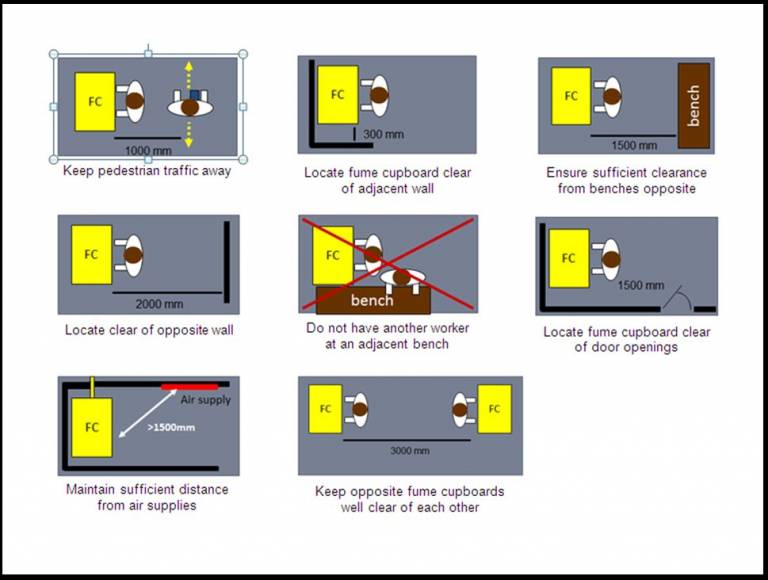
In addition to the above guidance, you must also consider the impact on escape routes from fume cupboard locations, for example ensuring there are alternative escape routes if a fume cupboard is located close to a fire exit. Contact Safety Services for further advice in this area.
- Microbiological Safety Cabinets
- Microbiological Safety Cabinets (MSCs, or MBSCs) are intended for work with biological agents, including pathogenic micro-organisms; genetically modified micro-organisms; cell cultures and human or animal tissues and fluids. There are three classes of Safety Cabinet - Class I, Class II and Class III.
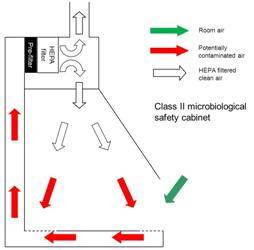
Class I cabinets are open fronted units which continuously draw air into the cabinet and out through a HEPA* filter, providing protection for the user but offering no product protection. They are suitable for use with hazard group 1, 2 or 3 organisms, subject to risk assessment.Class II cabinets are similar in design to Class I cabinets, but protect the working area from external contamination as well as protecting the operator. Inward air is directed downwards and below the work surface, HEPA filtered and then redirected back into the work area as a laminar down flow of clean air. The balance of this laminar down flow with the incoming air provides an air curtain to ensure operator protection. They are suitable for use with hazard group 1, 2 or 3 organisms, subject to risk assessment.
Class III cabinets are totally enclosed units in which operations are conducted through gloves attached to glove ports. Air enters and leaves the cabinet through a HEPA filter. They offer maximum operator and product protection and are suitable for work with organisms of all hazard groups, including group 4.
Most cabinets will be labelled as to their Class. If there is no label, you should be able to tell the class by looking inside the cabinet. Class I cabinets have a solid working space; Class II cabinets have a grille at the front of the working space where air is drawn into the cabinet before being recirculated down over the working area. The working space itself may also be perforated.
As with fume cupboards, Microbiological Safety Cabinets can be ducted or recirculating. Ducted cabinets will have a large exhaust duct sited at the top of the cabinet and extract air out of the building. Recirculating cabinets have no ducts but filter and re-circulate air back into the room. The filter plays a crucial role and therefore special considerations must be made:
- Selecting the correct type of filter
- Timely replacement and disposal of filters using a safe method - make sure you know the life span of the filter and ensure an expiry date is indicated
A risk assessment should be undertaken to determine the Class of cabinet appropriate for a particular work activity. This should take into account the nature of the potential hazards in terms of the micro-organisms involved and their route of infection, and also the techniques to be carried out and whether protection of samples is needed.
Siting of safety cabinets within a laboratory
Before installing a safety cabinet, ensure that you have checked that there is adequate space for a cabinet to work properly in everyday use. Air currents and the movement of people in the laboratory can adversely affect the cabinet's performance. Avoid siting cabinets near windows, doors, walkways, air diffusers, air conditioning units or adjacent to any fridge and incubator doors.
Use of bunsen burners
Bunsen burners and other naked flames should not be used in microbiological safety cabinets. As well as being a fire risk and potentially damaging filters, they will disturb air-flows inside the cabinet and could result in contaminated air escaping into the laboratory.
If burners are required, they must be low profile microburners equipped with a lever control to give full flame only as required, in order to minimise disturbance and used in Class I cabinets only. The burner should be placed towards the back of the cabinet away from any activity and the gas flow should be set at its lowest feasible level.
*HEPA = High-efficiency particulate air; a type of air filter capable of filtering very small particles and commonly used in work with biological agents.
- Capture Hood
- Capture hoods (or extraction arms) consist of a hood, funnel or other aperture attached to flexible trunking which is either routed to a movable motor/filtration unit or connected to central extraction system.
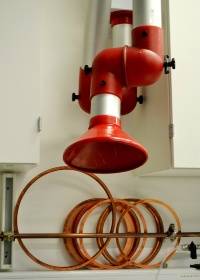
Capture hoods are designed to take away fumes, smoke, mists or dusts from the point of production and are commonly used in soldering or welding operations. The contaminated air is exhausted and filtered. The capture hood can also extract hot air generated during work.
The extraction potential of capture hoods is usually much more limited than fume cupboards and other, larger LEV as they are designed for small scale work and localised generation of contaminants.
Using a Capture Hood extract system
Before use:
- Check that the equipment is in a safe condition and the testing regime is current
- Check that the tubing will not be damaged by products of work processes, e.g. corrosion from fumes
- Check that all fittings are secure and no holes, misalignments or gaps in the system are present
- Run the equipment to purge the tubing of any residual contaminates before commencing work
- Report any faults and do not use if alarms sound or fault indicators show, or there is no suction felt on a gloved hand
In use:
- Place the capture hood over the work so that contaminated air is removed efficiently (recommended at a distance of no more than 10cm from the contaminant source) - smoke should not waft into your eyes or nose when working!
- Move the fume extraction around if you change work position
After use:
- Leave the system running after completion of the work to purge the trunking of any contaminants
- Clean the work area after use and remember to clean the hood / trunking on a regular basis
Maintenance
Testing and servicing regimes will vary depending on the work being carried out and the airborne contaminants being produced, however filters need changing on a regular basis. There is a statutory requirement that LEV, including capture hoods are tested every 14 months. The test status should be clearly displayed on the equipment.
Further advice
Effective extraction - fume capture is disrupted by drafts or convection processes. If you experience eye, nose, throat irritation or coughing when working, this indicated the extraction is not effective. Stop work and check the positioning of the capture hood.
Movable arms - ensure that any swing arms and other structures cannot work their way loose from the point of fixed attachment and cause injury or damage.
Damage - as portable devices, capture hoods are more susceptible to damage and require visual checks before and after use as well as a regular maintenance regime. Dedicated storage space can help protect deterioration and damage when not in use
- Gas Safety Cabinets
A gas cylinder storage cabinet is designed to provide safe containment of gas cylinders when they are installed within buildings. They provide physical protection, fire separation and ventilation to safely disperse any leaks that may occur.
Gas cylinders storage cabinets must have the following features:
- Be of fire resisting construction offering at least 30 minutes protection against fire
- Be provided with forced extract ventilation discharged to a safe location. For flammable gases the ducting will need to be fire resisting up to the point of any damper
- Have inlet and extract points fitted with automatic dampers to cut off air supply in the event the cabinet is exposed to a fire
- Be labelled to give an indication of the nature of the hazards of the gas
The following guidance should be followed:
- Gas cabinets should be dedicated to a specific gas or class of gases.
- All joints which are regularly broken and re-made should be positioned inside the cabinet as well as all associated valves, regulators and connectors
- Where possible, the air inside cabinets containing toxic gases and/or flammable gases should be monitored, with alarms, to detect leaks
- An alarm giving warning of extraction ventilation failure should be installed
- The cylinder supply should be interlocked and therefore shutdown in the event of ventilation failure or gas detector alarm
- The cabinet and all the equipment within the cabinet shall be electrically bonded to earth
The cabinet shall be provided with sufficient extraction ventilation with the aim of containing small leaks of gas and minimise their escape to the workroom. However, it is accepted no ventilation system would be able to deal with a major escape of gas. The extract volume should maintain the potential concentration of leaking flammable gases in the extracted air to below 25% of the lower flammable limit, except in the event of a catastrophic leak.
- Ventilated or Down Flow Benches
A ventilated / down flow bench is a bench which has a fume removal system driven by a fan. Contaminated air is extracted downwards through perforations in the bench work surface and through a central spigot. Ventilated/down flow benches can either be ducted to atmosphere or recirculating with carbon and HEPA filtration.
They are useful if working chemicals with low volatility and have been shown to be as successful as fume cupboards in dealing with contaminants. They have the advantage of allowing greatly improved access to the work area and can help reduce certain types of accidents such as those involving sharp implements. Ventilated / down flow benches are often used in dissection, autopsy or other histological work.
The limitations of these benches are that they may not contain projected particles as a result of an explosion and localised heating may adversely affect containment. Further, ventilated benches do not protect the user from bio hazardous substances - they are only useful for limiting potential exposure to fumes.
Unlike Laboratory Fume Cupboards, there is no set standard for use of ventilated/down flow benches.
The requirements of the COSHH Regulations should, therefore, be followed, including:
- Checking the performance at least annually using either a measure of containment or average air inflow velocities
- Conducting weekly or monthly visual checks to validate that the extract system is working
- Changing filters at intervals recommended by the manufacturer/supplier
Last updated: Wednesday, December 22, 2021
 Close
Close


